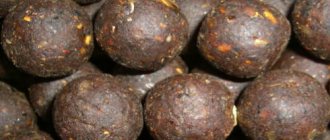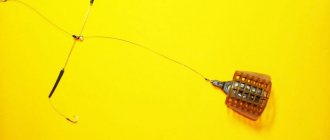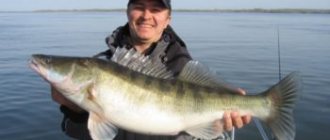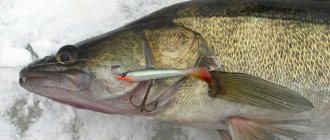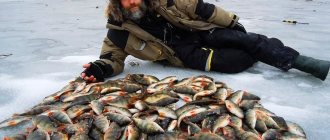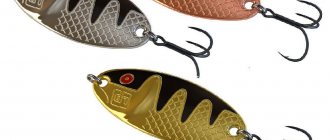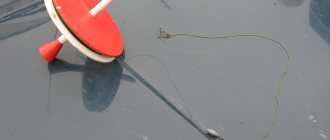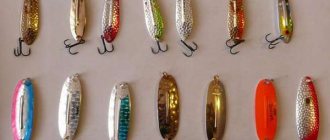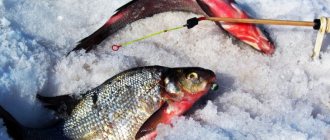Catching pike perch using bottom tackle is a fairly ancient, very interesting and unusual way. Every angler knows that no matter how many artificial baits there are, the most effective is always real bait.
It is not always possible to catch pike perch using a spinning rod in hard-to-reach places. Therefore, if the bite is not stable, such tackle is the best option. Using a fishing rod, after 1-2 casts the spinner moves to another place, while the bait is placed for a long period, and when the hunting instinct is activated, the predator gets hooked.
Habitats
This fish prefers places where the water is saturated with oxygen. This is one of the reasons that in the middle of winter there is practically no bite for this fish. At this time, the water is very poor in oxygen.
Since this is, as is well known, a bottom-dwelling fish, its habitats are located there, the deepest places. In small areas, pike perch avoids looking for food.
After spawning, this fish tries to go deeper. At this time, her behavior is completely different from the feeding that occurred for months before spawning.
Despite the fact that the majority of pike perch behave as described above, small individuals at the end of summer increasingly appear in places where the bottom is cluttered. We are talking about places where there are a lot of snags, algae, and remnants of old concrete structures under water. As an exception, single large specimens can hunt there. Therefore, such fishing is more likely to rely on random luck than on systematic success.
You can catch pike perch in winter, but you need to do it where it lives. Most often, such places are characterized by relatively warm water. For example, we can talk about water that is associated with runoff from cities, for example.
Fishing calendar by fishing season
Walleye behavior can change greatly over time. This applies to both seasonal and daily changes.
Starting from the first half of April, his hunger increases over the course of several months. This is due to the fact that the hungry winter has recently ended and to the fact that this fish is gradually eating up in order to prepare for spawning.
The cessation of zander's feeding is associated with the onset of spawning.
The zhor reaches its greatest strength at the time when the maximum rise of water occurs. After this, while this level gradually decreases, walleye activity gradually decreases. At this time, the behavior of this fish has interesting features.
The point is that pike perch gather in schools and, at the same time, due to competition, constantly lack food. Naturally, there is not enough food. As usual, the strongest win. That is, at this time a larger fish gets on the hook. This time lasts until mid-May.
Now, the spawning has passed, but the hunger does not come. At this time, adult fish are busy raising fry. They have the maximum feeding activity, but they are too small to catch (their weight will not be more than 600 grams - not a particularly attractive prey for a fisherman). At this time, fishing is not completely hopeless. A good catch of pike perch is quite possible, but this, most likely, can be attributed to fishing luck than to one or another of the habits of this fish.
With the onset of autumn, the autumn zhor begins. It is not as strong as it was in the spring, however, good catches are not uncommon at this time. It is especially important to take into account that at this time the fish gather in schools and find their own, specific habitats.
Now knowledge of such places where pike perch accumulates becomes important. Gradually the water cools down more and more. At the same time, the pike perch moves to deeper habitats. At this time, the favorite places are areas of the bottom drop, the depth of which is three meters or more. At this time, fishing from a boat rather than from the shore is more promising. First of all, this is due to the fact that this fish lives at depth at this time.
When the water becomes covered with ice, the pike perch bite increases, which gradually decreases, reaching its minimum in the second half of January. Now, until the spring feeding begins, the fish will be practically inactive.
What baits work best
Pike perch is a very cautious and changeable fish. Feels weather changes well. Therefore, before going to the pond, it would be a good idea to check with local fishermen (if possible) what the fanged fish last bit on. This will increase the fishing outcome.
If this is not possible, then it is necessary to diversify the number of baits you take with you as much as possible. It has been verified by experienced fishermen that bites most often occur on baits that are similar to the inhabitants of the reservoir where he hunts.
The bait most often used by experienced fishermen is:
- bulls
- gudgeon
- roach bait
- worms
- silver bream
- maggot
- sebel
- bleak
- leech
- perch
- barley shells
- crucian carp
- cancer (at night)
- frogs
If the goal is to catch a large trophy, then it is better to use larger bait. Live bait must be alive, since pike perch is a predator, not a scavenger.
How to plant a fry
The main goal of live bait is to attract a predator and force it to attack itself. Therefore, she will only be attractive if she is in an active state. Aquatic predators, like land predators, select weaker prey so as not to risk loss and not waste a lot of their energy.
A bait that cannot fully oscillate when hooked due to its attachment to the tackle. Thus, it creates tired vibrations in the body. Mounting methods:
- Through the mouth with a double hook. The method is applicable for medium flow.
- Between the dorsal fin and tail, closer to the center of the fish's body. It is necessary to attach it in such a way as not to damage the spine, otherwise the baitfish will be inactive. The hook must be placed under the scales from the tail side.
- The most convenient and reliable way would be the cunning gear of experienced fishermen. A rubber band is placed between the main fin and the tail. If you wrap the elastic tightly, it will never fall off. Thus, the angler keeps the bait absolutely intact without damage. The convergence is reduced to a minimum, in contrast to the first two methods.
You can plant it in different ways. But how the angler hooks the fish determines how much longer it will live and whether it will fall off the hook.
Advantages and disadvantages of using bottom gear
Such gear is designed for catching certain types of fish, including pike perch.
In general, there are 3 main methods of bottom fishing:
- Simple bottom fishing rod. In this case, you need to use a short and powerful rod. When installing the tackle, a relatively heavy sinker is installed and two or more leashes with hooks are attached to the main line. The weight of the sinker can reach 50 grams or more. In some cases, a sinker weighing up to 100 grams can be used. When casting, the hooks are caught at the very bottom. The disadvantage of this method is that you have to cast relatively often, and the noise from it can scare away the fish and it will simply go to a quieter place.
- The next method is fishing with an elastic band . It is not customary to use a fishing rod here. Usually the fishing line, tackle with hooks and feeder, and elastic band are pre-wound on the reel. On the first cast, the main line is directly attached to the elastic without using any gear at this point. A heavy weight is thrown into the desired place. Then the line is pulled back until an elastic band appears. After this, the tackle with leashes and a feeder is mounted, which is attached to the elastic band on one side by a swivel with a latch, and on the other side in the same way to the main fishing line. After this, the line is released - and the tackle goes under the water and ends up in the right place. The remaining part of the fishing line is wound on a reel, which is fixed to the ground. Such tackle disturbs the fish less when casting and contributes to more accurate casting of the tackle.
- The third method is to use a spinning rod with a reel . Both inertial and non-inertial coils can be used. The tackle is attached to the end of the main line along with leashes and a feeder. Then it is abandoned in the same way as in other similar cases.
It remains to emphasize the following. In each of these methods, fishing is possible both with and without a feeder. You can also fish from the shore or from a boat. In the latter case, the casting will be more accurate, and the safety of the bait will be better than when casting from the shore.
Another important characteristic property of bottom tackle is the use of a heavier sinker and relatively stronger fishing line. Usually they take one whose thickness is 0.35 mm or more.
pros
- This fishing method allows you to install fishing gear at different depths. This allows you to better match the habits of the fish in the relevant situation.
- You can fish or cast bait up to 80 meters. Thanks to this, you can fish from the shore not only close, but also at a sufficient distance.
- When bottom fishing, you can effectively use a bite alarm. Its signal will not allow you to miss bites even if you were not attentive enough or it was difficult to determine.
- Even when the weather is difficult (gusts of rain or strong wind), such an alarm will not allow you to miss a bite.
- Nothing prevents you from combining fishing and baiting. This significantly increases the chances of a good catch. Here we are talking not only about the feeder feeder, but also about additional bait.
Minuses
- Unfortunately, bottom fishing is not applicable everywhere. For example, on mountain rivers or in any places where there is a strong current or the bottom has a strong slope.
- Although the fact that the weight is located on the bottom, which allows some degree of adjustment of the height of the hooks, provides certain opportunities for the fisherman, this gear is not intended for fishing under the surface of the water.
- Where the bottom is heavily overgrown with algae, bottom tackle becomes much less effective.
- It can also be argued that the bottom, replete with snags, is also not suitable for such gear.
What to use depending on the conditions
The gear is used among the main bottom fishing rods. They are almost no different from those used to catch peaceful fish. Their only difference is a more reliable and robust design. Larger diameter of the leader, powerful size and shank of the hook, powerful reel from 2500 (size/Shimano), larger spinning rod test from 40–50 g.
From the shore
The set is like this:
- Throwback - a reel tied to a small peg, a sliding sinker and 1-3 fluorocarbon leaders.
- A spinning rod with a length of at least 2.4 m. As described above in this article.
- Bottom rubber band (just like for peaceful fish, but with more powerful fishing lines).
From the boat
You will need:
- Sheer bottom - placed at depths where long casting is not needed. You can use either a reel or a reel with a small rod.
- A short spinning rod no longer than 1.7 m.
- All types of gear (except for elastic) can be used wired. But the wiring must be done very slowly and smoothly. So that the bait does not get caught on snags or grass.
However, this has more to do with jig fishing. All signaling devices are used for the donk. Bells, electronic, in the dark - light.
Composition of bottom tackle for pike perch
As mentioned above, there are several main types of bottom tackle. Here we will talk about one of them, which is the most common.
- Fishing rod . It is believed that a fishing rod for bottom fishing should not be longer than 2.5-3 m. If we are talking about a reservoir where there is a weak current or no current at all, then a test characteristic of 40-60 grams is quite suitable. If we are talking about areas with strong currents, then the requirements will be higher - a test of 100 grams will be required.
- Reel _ As mentioned above, a reel can be used for bottom fishing, but there are also options when it is not used. Now we are talking specifically about spinning bottom fishing. In this case, a spinning reel with a spool rating of 3000 is most suitable. It will be great if this model has a drag and a “baitrunner” system.
- Fishing line . Considering the fact that when bottom fishing for pike perch, they rely on fairly large fish, you need to take the appropriate fishing line. Its thickness should, as a rule, be at least 0.35 mm.
- Feeder .
Using a feeder when bottom fishing is very effective. It simultaneously feeds fish and acts as a sinker when casting. If you choose the right type of feeder, it will lock in the right place after being thrown. Unfortunately, with strong currents, in some cases the feeder may begin to move chaotically, which can reduce the effectiveness of fishing.
Making donka yourself
Let's tell you in more detail about the manufacture of one of the most popular types of bottom gear: fishing using a spinning rod and a feeder. This method is also called feeder fishing.
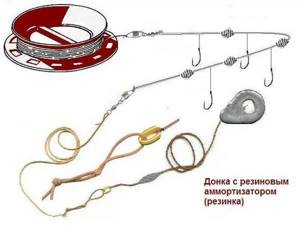
What you need
- You can take a budget fishing rod; it should not be too long: a length of 2-2.5 m is sufficient.
- Let's take a spinning reel of the inertialess type. A spool with a 3000 rating would be suitable. If a “baitrunner” system and a drag are provided, that would be good. If they are not available, then such a coil can also be used.
- Let's take 100 m of monofilament with a thickness of 0.3 mm.
- Let's prepare hooks, the size of which is 6, 7 or 8.
- It is necessary to provide a bite alarm. One option is a bell.
- The weight of the sinker should be between 50 and 100 grams.
- The leading line is taken with a thickness of 0.2 mm.
Installation
- Let's prepare the rod from the very beginning. The reel and rings must be exactly in a row, and their attachment should be as strong as possible.
- We pass the fishing line through all the installed rings, making a loop at the end and putting it on the bobbin. Now we completely reel in the fishing line.
- When installed on a fishing line, the sinker must be able to slide. Where there will be an extreme position, we install a stopper on the fishing line. We make a loop at the end of the fishing line. For this, in particular, you can use the figure eight knot. An equipment is then attached to it, consisting of a leash (it is convenient to use not 1, but 2 leashes) and a feeder.
- It is necessary to provide a mount for the fishing rod. After casting, it will need to be securely installed, using a bite alarm.
Installation and step-by-step assembly
It is very important to follow all the steps here in order to avoid such mistakes as fish disappearances and spinning rod breakdowns. You can easily figure out how to assemble the donkey if you have instructions.
Spinning rods and their assembly:
- The layout of the telescopic spinning rod begins by pulling the tip to the beginning of the handle. It is very important to place all the guides in one row to avoid the fishing line loops getting caught on the rod.
- Plug rod. Before assembly, the mounting points are checked for dirt and excess debris, then assembled.
- Coil attachment and assembly:
- The coil is landing on the butt. There is rarely a latch near the handle, the fastening of which is clamped on two, and sometimes on one side, with nuts (depending on the model).
- We wind the fishing line (braid) onto the spool of the reel.
- The edge of the fishing line is pulled through all the rings, starting from the small one on the form to the beginning of the spinning rod holder.
- Next, the reel bracket is folded back and the line is wound in 2 turns. It is tied on the spool with a simple tightening knot.
- Close the line guide bracket.
- The line on the side of the reel (purchased reel) must be tensioned so that the line does not sag. It wound smoothly onto the bobbin without any slight holes or weak spots on the bobbin thread. Otherwise, when casting the bait, there will be a loop or knot.
Making leashes:
- It is necessary to prepare pieces of fishing line 30–70 cm.
- Sharp hooks with a thick shank.
- A loop is made on one side of the fishing line and a hook is crocheted on the other.
- Moisten the knot before tightening for stronger compression.
To secure the feeder, Paternoster equipment is used. Items you will need:
- feeder
- monofilament
- swivel
- fluorocarbon line
- hooks
We knit the tackle:
- We measure 45–50 cm from the main monofilament line and cut it off.
- We fold the fishing line in half so that one end sticks out 10 cm more than the other.
- We fix the swivel using the throwing method.
- We attach a carabiner to it, and a feeder through it.
- A knot (double) is tied 10 cm below the swivel.
- Small loops are made at the end of the lines.
- Take another piece of fishing line 100 cm.
- There is a hook on one side and a small loop on the other side.
- The leash is attached to the feeder using a loop-to-loop method (in the same place as the main line).
- The main monofilament line is attached in the same way.
- The tackle is ready. You can start preparing the bait.
What to lure with?
When fishing for pike perch, you can use a variety of baits.
In some cases, even a fairly large jig may be suitable. Although we are talking about a predatory fish, it bites on a variety of types of bait. This is especially true during periods of zhora, which are typical for this type of fish.
The “omnivorousness” of pike perch is most evident during the spring feast. At this time, using even ordinary porridge will be effective. A good alternative when fishing for pike perch is to use worms .
live bait is best suited to lure it .
Choosing bait and how to use it correctly
Pike perch in nature does not hunt wide-bodied fish, so to catch it it is important to use exclusively narrow-bodied species.
Depending on the region, the best baits are:
- gudgeon;
- goby;
- spike;
- bleak;
- a small handful of worms;
- lamprey (larvae).
Read more
What to feed bream in spring?
Pike perch does not belong to the group of orderlies or scavengers; to catch it, the bait must be fresh and active. Dead or inactive bait is ineffective on this predator. If there are no bites, check the bait once every 15-30 minutes. A weak, barely mobile fish is attractive exclusively to a hungry predator, but still bites very rarely.
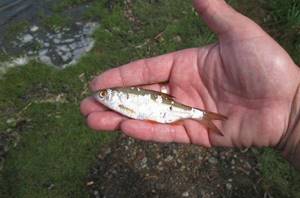
The undoubted advantage of donkey is the presence of live bait, which moves and has a real smell.
If small live bait is used, provided the skin is strong, it is better to place it behind the head, dorsal or anal fin. The strength of the bait's fixation remains an important point, otherwise the nozzle will fly off during casting.
Fishing with sprat often proves effective. Pike perch loves small fish very much, but they are lethargic. To increase the activity of the bait, be sure to pull up the tackle every 5-10 minutes. Fishing with sprat has proven itself well when installing two hooks.
Techniques and tactics of catching pike perch on a donk
For fishing, places are chosen where there is a current, although not too strong. The bottom should be sandy or rocky, pike perch loves this. The depth at the fishing spot can be from 4 to 6 meters. First you need to catch some live bait. It could be bleak or small roach.
When fishing, you can make 2 or 3 casts at the same time (use 2 or 3 fishing rods at the same time and secure them on the shore in anticipation of a bite) and stay close to them all the time. A pike perch bite looks like a sharp blow. The bite alarm will help you not to miss it.
If the fish breaks, the tackle needs to be re-thrown.
After that, we fish out the fish that caught our hook.
Benefits of Sudok Donkey
Our grandfathers made pike-perch donks and, in a slightly modified form, these tackles have “survived” to this day. This is already evidence that zander donks are catchy and productive.
In addition, among the advantages of bottom fishing for pike perch, the following should be highlighted:
- the ability to catch a predator at any time of the day and in any weather;
- the use of long casts to fish holding areas;
- no noise when casting gear that scares away fish;
- catcher's tackle for various types of reservoirs, both in still water and in the current;
- when fishing with a donk, you can not only catch, but also feed fish at the same time;
- different baits are used, including live bait;
- It is easier for the fisherman to find out about a bite, since a signaling device is used.
We have already talked about the fact that pike perch can be caught with bottom fishing even at night, but we should not forget about the factor of weather conditions. Rain, wind, or sunny weather does not matter; if you want to go fishing for pike perch with a donka, then this must be done.
People fish with bottom tackle both from the shore and from a boat, but the advantage of classic pike-perch rig is that it can be cast at a distance of up to 60 meters and further, it all depends on the rod and reel.
Fishing at such a distance and at great depths ensures that the fish will not be afraid of extraneous and unusual sounds, and therefore will approach the bait without fear and taste it.
But the use of bite alarms frees up the fisherman’s hands and allows him to use several rods with equipment, which means increasing the likelihood of a good catch. Thanks to the presence of a signaling device, you always have time to react to a bite and confidently hook the fish.
In addition, when catching pike perch on a winter bottom, some types of bait are used, and others in the fall or summer. These include artificial baits and live bait and spinners, the main thing is that the bait is to the liking of the pike perch, and he wants to feast on it.
Tips and tricks
- In hot weather, you need to look for it where there are deep holes and shade of trees.
- At the end of summer, flocks of large individuals hunt in the shallows. At this time they become relatively easy prey.
- Although it is customary to use a fairly strong fishing line for bottom fishing, if in a particular place there are no specimens larger than 1.5 kg, you can use a thinner fishing line.
- If you are going to catch pike perch from a boat, then you do not need to use a rod longer than 2 m. For fishing from the shore, you can take a longer rod.
